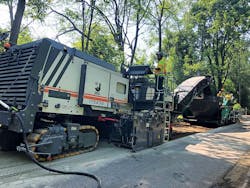Rediscovering yourself sometimes calls for a major purchase. The Jackson County, Mich., Department of Transportation is not ashamed of holding the receipt.
Business as usual was not going to help 900 miles of road take a turn for the better. Officials knew something different had to be done, and the Jackson County DOT changed the face of its maintenance operations. The agency is now depending on cold in-place recycling (CIR) to turn things around. The first attempt at CIR for Jackson County, which occurred on a $329,000, 1.05-mile line on Rosehill Road between Cooper Road and N. Elm Road in Blackman Township, led to the first of many recognitions, as the project earned a 2019 Roads & Bridges/Asphalt Recycling and Reclaiming Association Recycling Award.
“I started talking to my team [about CIR] and we all felt it was the right thing to do—the technology is ready and the time is now,” Christopher Bolt, managing director for the Jackson County DOT, told Roads & Bridges. “Our board stood behind us, and that’s an amazing side story to this as well. We are hoping to spur a new marketplace.”
Taking it from the bottom
Jackson County not only stood behind the project, it also threw plenty of money at it. The county made the decision to buy $6 million worth of equipment, including a lab to develop mix designs and a ground-penetrating radar vehicle with roughness sensors and LiDAR scanning equipment, and also sent an entire team down to the headquarters of Wirtgen in Nashville, Tenn., for three days of classroom and hands-on training in early May 2018. A group of engineers also visited Orange County, Fla., Ontario, Canada, and Texas A&M University. The crew came back ready for action, and attacked the Rosehill Road project in late June. Wirtgen and AIS Equipment, a Lansing, Mich. based equipment sales firm, sent several experts to address any questions and to assure the quality of the job.
“Ours is a comprehensive approach, the first municipally owned and operated program in the state and the nation, quite possibly the world,” said Bolt. “Wirtgen was telling us to its knowledge no one else was doing it quite like this. Our road system is in bad enough shape that we figure [asphalt recycling] is our new way of life for the next 20, maybe 30 years. Recycling every road is our goal because we believe it provides a much more durable base.”
The new 6- to 8-in. base is what is giving Rosehill Road the title of “super road,” and is where the CIR process was used. Due to the fact that Rosehill serves as a detour route for I-94, truck traffic can spike, calling for additional strength. The structural coefficient for the new bound aggregate base (BAB) is almost equivalent to virgin hot-mix asphalt. The typical county road can feasibly achieve a total structural number of 2.6 or 2.8 considering budgetary restraints. This section of Rosehill Road now has a structural number of about 4.0. Unlike a crushed aggregate base, the wet strength of the recycled base course retains 70-80% of its dry strength.
“So with typical construction methods, you build it from the top down in terms of strength,” Angela Kline, director of engineering and deputy managing director for the Jackson County DOT, told Roads & Bridges. “With this process, it’s built from the bottom up.”
Before work began on Rosehill, the section was full of alligator cracking, potholes and raveling. The state of Michigan uses a PASER (Pavement Surface Evaluation and Rating) scale on its roads, with a score of 10 given to a new road. Rosehill Road received a 3.
A Wirtgen W 150 mill with variable drum width capabilities came in first and milled a 3-ft-wide keyway, 8 in. deep, along the edges of the roadway so that Rosehill could be widened to 24 ft.
A small steel double-drum roller compacted the trench, and then a Streumaster followed spreading portland cement (the mix called for 1% cement). A truck pulled the tank full of PG 58-28 liquid asphalt, which was trucked in from Bay City, located three hours from the jobsite. The liquid asphalt left Bay City at 380°F and was at least 320° to 350° at laydown. The mix design called for 2.2% asphalt oil as part of the foamed asphalt process, which “spot welds” the crushed road pieces together to form the new base. The tanker trailer was hooked on to a Wirtgen CR 3800 recycler, which mixed the recycled material, oil and water before feeding it to a Vogele Super 2000-3i vibratory screed paver. The 3800 was initally cutting at 8 in., but that was quickly reduced to about 6 to 7 in., when it was discovered that some undesirable sandy subgrade material was at or just below the 8 in. depth mark, which in turn can contribute to quality issues with the recycled base material. The newly paved base material was compacted to 80% off the asphalt screed, then a Hamm HD+ 120i steel double-drum roller operating on a high amplitude, low frequency setting, and a Hamm GRW 180i pneumatic roller followed. The steel drum and pneumatic roller made around seven passes each to achieve a target density of 95%. The mix contained 10% air voids. A Troxler 3430 nuclear gauge was used about every 500 ft to test for density.
As the job went on, the most difficult challenge was handling the recycling material due to a general 10% expansion. Moreover, due to the heavy deterioration in the existing roadway, there was an extreme variation in the cross-section and slope, which in turn led to a variation in the amount of recycled material in any particular span of the recycled section. In some spans an excess of material was encountered, which would have to be off-loaded into a standby dump truck. In other spans a shortage of material was found, requiring the previously off-loaded material to be brought back and loaded into the paver.
“The issue we ran into repeatedly was starvation of material because the cross section of the road was uneven,” Doug Steffen, engineering technician and acting director for construction and recycling operations for the Jackson County DOT, told Roads & Bridges. “We started watching the material in the hopper much closer. If we had something really drastic, we didn’t run slope, but most of the time we still were able to achieve slope.”
Because the hopper that fed the paver was new and freshly painted, the crew discovered some of the material was sticking to the hopper walls. The paint was removed with an electric grinder with a wire wheel attachment, and electric vibration units were installed on the hopper.
After the base was finished, contractor Michigan Paving & Materials Co. came in and laid a 3.5-in. hot-mix asphalt surface layer. The surface consisted of two lifts. The leveling course was 2 in. thick and contained a PG 58-28 binder. The wearing course was 1.5 in. thick and also contained a PG 58-28 binder. A Caterpillar 1055 asphalt paver formed the mat. Two Caterpillar XW54 steel double-drum rollers were used for compaction. The breakdown roller made five low-amplitude, high-frequency passes tight to the paver, while the finish roller made three passes on low vibe, high frequency and two passes on static when the pavement was under 190°F. At 120-130°F the finish roller passed over three more times for cosmetic finishing.
Dismissing a monster
Prior to the Rosehill Road endeavor, Bolt discovered some resistance amongst Michigan contractors when it came to recycling. In the past, there were only one or two contractors that routinely expressed interest in coming into Michigan for recycling projects, leading Jackson County to purchase its own equipment.
“We were one of the few states that didn’t do a lot with recycling roads, and so we got some backlash,” said Bolt. “Our board took some heat as they were contemplating the decision, but they had faith in us.
“It’s been really quiet [since the Rosehill job] because we have reassured our local paving company. The big, hairy monster left the room, so to speak, and I think the contractors realized that once we mill off that top layer of asphalt we do need the roads to be repaved.”
Jackson County also now has a KMA 220i Wirtgen mobile cold recycling plant and purchased two 35,000-gal vertical asphalt oil storage tanks so that receiving the oil would not require a three-hour drive. During the Rosehill job, the Jackson County crew constantly battled Michigan’s hours-of-service law for truck drivers. Drivers can only drive 11 hours and must have a 10-hour break between shifts.
“We had some instances where they were clocking into their log book at 2 a.m. to get us material by 6 or 7 in the morning, and then they have a three-hour drive back. So the next day we weren’t able to start construction until sometimes 9 or 10 a.m. because the truck would not get there until late,” said Steffen.
There are about 900 miles of road that require immediate attention in Jackson County, and the target for 2019 is at least 48 asphalt road recycling projects.
“We are excited,” said Bolt. “We think we are on the right path.”



